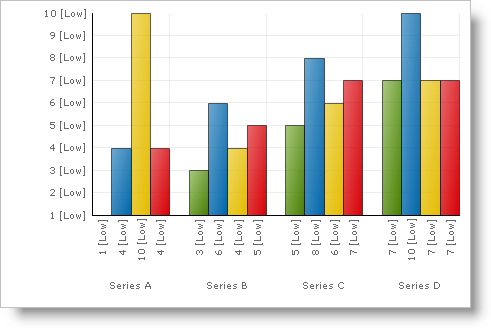context["ITEM_LABEL"]
Developers can implement IRenderLabel to surpass the capabilities of Chart label format strings.
IRenderLabel is a simple interface with only one member, ToString . Within this method is a single argument called "context ", which is a Hashtable containing values that pertain to the current label being printed. For example:
The return value of ToString is the string value that will be printed on the chart in the specified context. If the ToString method always returns "Hello World," then "Hello World" will appear repeatedly on the X axis, if the UltraChart.Axis.X.Labels.ItemFormatString property is configured to use IRenderLabel implementation.
The following is example code for the IRenderLabel class:
In Visual Basic:
Imports Infragistics.UltraChart.Resources
...
Public Class MyLabelRenderer
Implements IRenderLabel
Public OverLoads Function ToString(ByVal context As Hashtable) _
As String Implements IRenderLabel.ToString
Select Case CDbl(Context("DATA_VALUE"))
Case Is > 1000
Return CStr(context("DATA_VALUE")) & " [Very High]"
Case Is > 100
Return CStr(context("DATA_VALUE")) & " [High]"
Case Is > 10
Return CStr(context("DATA_VALUE")) & " [Medium]"
Case Is >= 0
Return CStr(context("DATA_VALUE")) & " [Low]"
Case Else
Return CStr(context("DATA_VALUE")) & " [Negative]"
End Select
End Function
End Class
In C#:
using Infragistics.UltraChart.Resources;
...
public class MyLabelRenderer : IRenderLabel
{
public string ToString(Hashtable context)
{
double dataValue = (double)context["DATA_VALUE"];
if (dataValue > 75)
return dataValue.ToString() + " [Very High]";
else if (dataValue > 50)
return dataValue.ToString() + " [High]";
else if (dataValue > 25)
return dataValue.ToString() + " [Medium]";
else if (dataValue >= 0)
return dataValue.ToString() + " [Low]";
else
return dataValue.ToString() + " [Negative]";
}
}
Set the appropriate FormatString property to a unique string value enclosed by "<" and ">" characters.
Create a Hashtable with an entry containing that unique string value without the "<" and ">" characters, and an instance of an IRenderLabel implementation.
Set the UltraChart.LabelHash property value to the Hashtable containing the IRenderLabel implementation.
In Visual Basic:
Private Sub Customize_Labels_Using_the_IRenderLabel_Interface_Load( _
ByVal sender As System.Object, _
ByVal e As System.EventArgs) Handles MyBase.Load
Me.UltraChart1.Axis.Y.Labels.ItemFormatString = "<MY_VALUE>"
Me.UltraChart1.Axis.X.Labels.ItemFormatString = "<MY_VALUE>"
Dim MyLabelHashTable As New Hashtable()
MyLabelHashTable.Add("MY_VALUE", New MyLabelRenderer())
Me.UltraChart1.LabelHash = MyLabelHashTable
End Sub
In C#:
private void Customize_Labels_Using_the_IRenderLabel_Interface_Load(object sender,
EventArgs e)
{
this.ultraChart1.Axis.Y.Labels.ItemFormatString = "<MY_VALUE>";
this.ultraChart1.Axis.X.Labels.ItemFormatString = "<MY_VALUE>";
Hashtable MyLabelHashTable = new Hashtable();
MyLabelHashTable.Add("MY_VALUE", new MyLabelRenderer());
this.ultraChart1.LabelHash = MyLabelHashTable;
this.ultraChart1.DataSource = GetColumnData();
}
